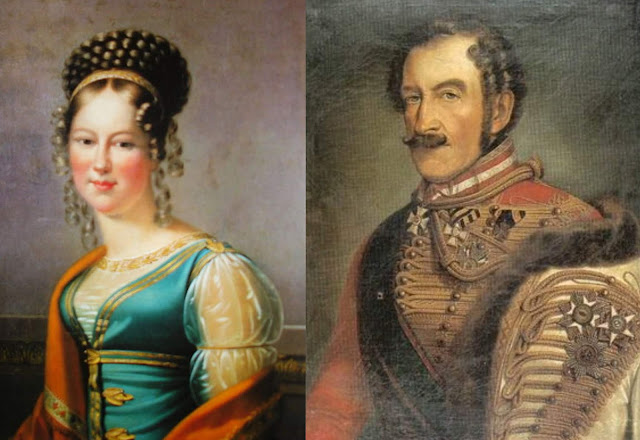 |
| Princess Antonia Kohary (left) and Prince Ferdinand of Saxed-Coburg and Gotha |
At the turn of the 19th century, one woman, while not a full-fledged royal, stood out as the wealthiest of them all. She was extremely wealthy that the emperor elevated her family into princely status right before her marriage to a relatively unknown prince. Princess Maria Antonia of Kohary eventually raised children who would occupy the thrones of European kingdoms.
Early Years
Countess Maria Antonia Koháry de Csábrág et Szitnya was born on July 2, 1797 in Buda, the ancient capital of Hungary. She was the second child of Franz Josef, Count Koháry, and his wife, Countess Maria Antoinetta Josefa von Waldstein-Wartenburg. Maria Antonia’s older brother, Franz, died on April 19, 1795 at the age of two, making her the only heir to the House of Koháry. The family owned extensive landholdings that stretched 150,000 hectares of land located in present-day Lower Austria, Slovakia, and Hungary, making them one of the wealthiest families in the Austro-Hungarian empire.
Marriage and Family
Maria Antonia married Prince Ferdinand of Saxe-Coburg and Gotha on November 30, 1815 in Vienna, Austria. The prince was an older brother of Prince Leopold, future King of the Belgians, who was then the husband of Princess Charlotte of Wales. His younger sister was Victoria, the Duchess of Kent, mother of the future Queen Victoria. In order to make her an eligible bride to a ducal prince, Emperor Franz I elevated Maria Antonia’s father to Prince Koháry of Csábrág and Szitny in Austria's nobility two weeks before the wedding, therefore making the countess a princess.
The marriage between Prince Ferdinand and Antonia was celebrated in the grandest manner. Never before had Vienna seen such a wedding. The festivities, where an orchestra of 790 gypsies played Hungarian folk songs, lasted for nine days! She was proclaimed "heiress of the name" (fíúsított) and her husband Prince Ferdinand of Saxe-Coburg and Gotha took the name Saxe-Coburg and Gotha-Koháry. Their marriage bore four children: Ferdinand (1816–1885), who became King of Portugal as Ferdinand II in 1869, and whose grandson and namesake became King of Romania in 1914; August (1818–1881), whose son Ferdinand was elected Prince of Bulgaria in 1887 and was elevated to tsar (king) in 1908; Victoria, whose son Gaston was the consort of Isabel, Princess Imperial and heiress of Emperor Pedro II of Brazil; and Leopold (1824–1884).
A Very Wealthy Princess
On the death of Prince Franz Josef in 1826, Antonia inherited his entire fortune of 20 million francs, making her one of the wealthiest women in Europe. When her son, August, married the equally wealthy Princess Clementine of Orleans, a list of assets attached to the marriage contract revealed that Antonia's holdings included the massive Palais Coburg in Vienna and a number of manors in Vienna, a summer home and lands at Ebenthal in Lower Austria, estates at Velm, Durnkrut, Walterskirchen, Bohmischdrut and Althoflein in Austria, as well as a dozen manors in Hungary, the domain of Kiralytia, and a mansion at Pest. The family’s extensive holdings also included forests, mines and factories.
In 1868, when Antónia's grandson Prince Ferdinand, Duke of Alencon, married, it was estimated that he and his three siblings inherited a total of one million francs from their grandmother. In fact, the Saxe-Coburg-Kohárys remained among the largest landowners in Hungary until World War I. Two family trusts were established to manage the family holdings for the benefit of the family members, the Prinz Ferdinand Coburgsches Fideikommiss and Gräflich Kohárysches Fideikomiss. This system was common among aristocratic families to finance the representative household of the head of the family, as well as to maintain palaces and castles, and support members of the family who did not have their own fortune.
Princess Maria Antonia Koháry died on September 25, 1862 in Vienna, Austria. She was 65 years old. She was buried in the ducal mausoleum of Friedhof am Glockenberg.

.png)





0 Comments